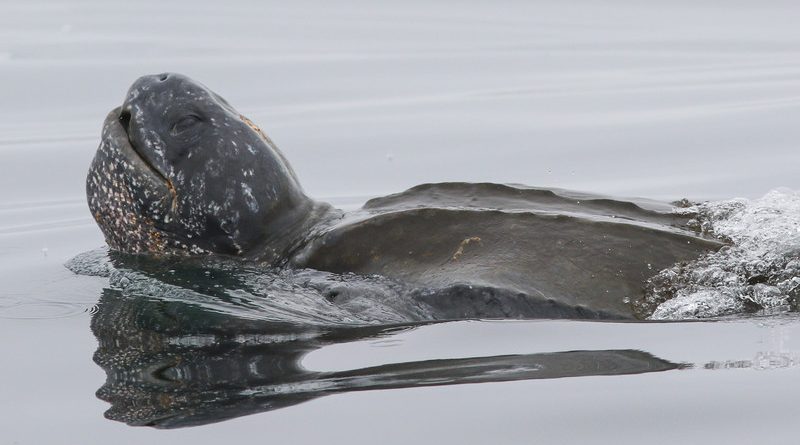Pacific leatherback sea turtle inches closer to endangered status
California Fish and Game Commission backs a plan to help the species avoid continued population decline.
SACRAMENTO—A plan to place the Pacific leatherback sea turtle on the California Endangered Species List was approved by the state’s Fish and Game Commission in mid-August. The petition urging California to take steps to grant the Pacific leatherback sea turtle protections under state law was brought to the Fish and Game Commission by the Center for Biological Diversity and Turtle Island Restoration Network.
The unique turtle species is now a candidate for threatened or endangered status under the California Endangered Species Act, thanks to all five members of the Fish and Game Commission voting in favor of the petition.
Pacific leatherback sea turtles are generally present in or near California waters in spring, summer and fall months.
California’s beaches, according to the petition filed with the state’s Fish and Game Commission, has become a nesting grounds for the Pacific leatherback sea turtle.
“A new review of leatherback sea turtle science released last week concludes that West Pacific leatherbacks, one of seven distinct populations of leatherback sea turtles world-wide, face a high extinction risk,” Center for Biological Diversity staff said in a released statement. “The National Marine Fisheries Service and U.S. Fish and Wildlife Service found that all seven leatherback sea turtle populations remain endangered and denied a petition by the commercial fishing industry to relax some protections.”
Entanglement and drowning in longline gear are cited as common reasons for the species’ population decline. The urgency for threatened or endangered status, however, appeared to increase in October 2019, when the Trump administration allowed for longline fishing off the California coast.
Longlines can stretch up to 60 miles in length and have thousands of baited hookes attached.
“Each year from mid-summer through the fall, leatherback sea turtles, having completed a journey of thousands of miles from their nesting beaches in Indonesia, arrive off the U.S. West Coast to feed on seasonably abundant jellyfish in the California Current ecosystem. California has named the Pacific leatherback sea turtle as the official state marine reptile and designated October 15 as Pacific Leatherback Sea Turtle Conservation Day,” the filed petition stated.
The Center for Biological Diversity and Turtle Island Restoration Network both stated the protection of the Pacific leatherback sea turtle under the California Endangered Species Act would “ensure the continued existence of [the] critically endangered species.”
“State listing will prohibit catch of leatherback sea turtles incidental to fishing,” the petition stated. “Vessels participating in California-managed fisheries may apply for an incidental take permit, which would be required unless a federal incidental take statement exists. This will require state and federal cooperation in addressing threats to leatherback sea turtles.”
Annalisa Batanides Tuel, a policy and advocacy manager with Turtle Island Restoration Network, said the Pacific leatherback sea turtle is on the verge of extinction due to man-made threats.
She told commissioners the Pacific leatherback sea turtle has been in a population decline since the 1980s. The population has specifically declined 90 percent during the previous four decades, according to the petition to list the Pacific leatherback sea turtle as an endangered or threatened species.
“The primary threats to the survival of the species include drowning in industrial fishing gear, especially the longline gillnet gear, entanglement in vertical lines and groundfish pots, Dungeness crab traps and other forms of marine debris,” Tuel said.
Tuel added the Pacific leatherback sea turtle population will remain stagnant if only one leatherback dies per year. The population will be in decline if two or more Pacific leatherback sea turtles die per year, she added.
“Just in the past five years, we already had three interactions in between fisheries and Pacific leatherbacks in California waters – two of which resulted in leatherback deaths,” Tuel said. “Now is the time to increase protections and ensure the protection of the species.”
Tuel emphasized there is little that could be done to protect Pacific leatherback sea turtles in international waters, but California should allow for as many protections as possible once the species enters the state’s jurisdiction.
The Pacific leatherback sea turtle is unique in that it is the only turtle species with a soft shell. Adult leatherbacks can measure up to 7 feet in length and weigh nearly 2,000 pounds once mature. The species could experience a 96 percent population loss by 2040.
“An estimated 50 West Pacific leatherbacks forage in California waters annually, as compared to 178 West Pacific leatherbacks during the years 1990-2003,” Center for Biological Diversity staff said in a released statement.
California’s Department of Fish and Wildlife will now begin a one-year review process to determine whether the Pacific leatherback sea turtle warrants protection under the California Endangered Species Act. The act’s protections will be applied to the species during the review process, according to the Center for Biological Diversity.



Just watching a program on jellyfish and how the leatherback turtles eat them.
Why not have a habitat for reproducing leatherback turtles to save the turtles and reduce the jellyfish?
Program National Geographic Wild